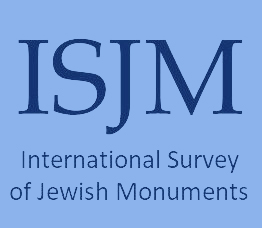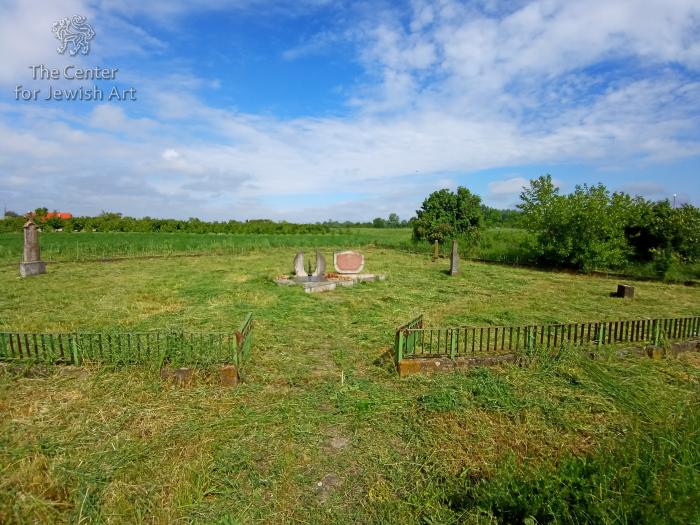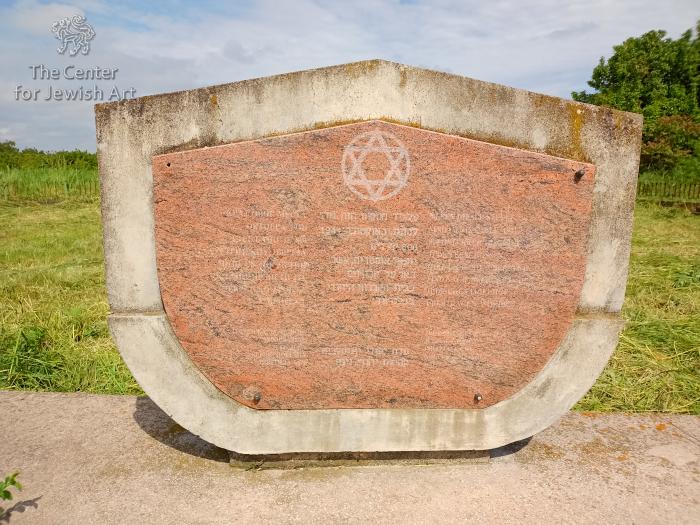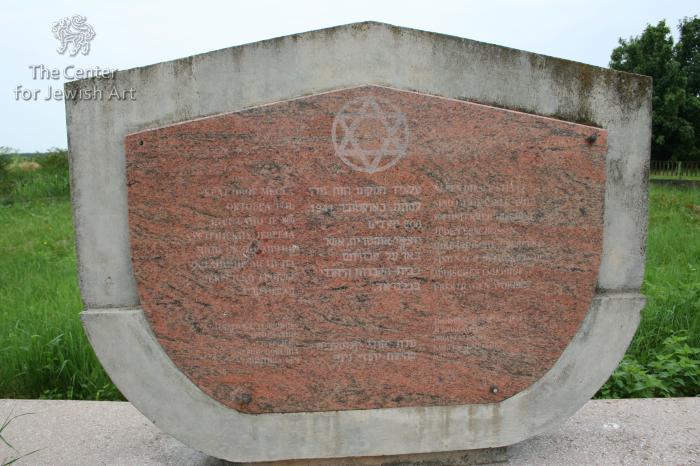Obj. ID: 50032 Holocaust Memorial in Zasavica II, Serbia, 1977, 2001
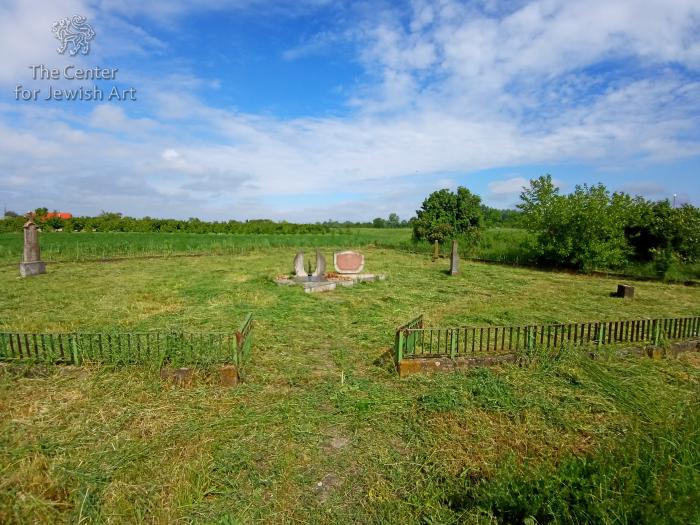
Memorial Name
No official name
Who is Comemmorated?
The over one-thousand Jewish and Roma Holocaust Victims murdered near this spot on October 12 and 13, 1941
Description
This memorial complex consists of five monuments set in a triangular space, surrounded by a low fence in a combination of concrete and metal bars. The central monument was unveiled on July 7, 1977. The last memorial unveiled is dedicated to the Jewish victims, erected in 2001.
The central monument has the shape of a stylized flower; two petals made of concrete with a brass inlay, and several brass rods that represent flower pistils. The memorial lies on a square platform on which is mounted a granite commemorative plaque with a text in Serbo-Croatian.
The central monument and the monument to the Jewish victims are adjacent to one another. The monument to the Jewish victims is a stele made of reddish and white marble shaped like a vertical slab with a pointed arch, featuring a Magen David and commemorative inscriptions in Serbo-Croatian, Hebrew, and German. The monument lies on a triangular platform made of concrete.
To the left of the central monument is a tombstone made of reddish marble with a cross on top, engraved with the sickle and hammer and five-pointed star, and a commemorative inscription. The two remaining monuments of the complex commemorate individual victims and were erected immediately after the war by their family members. These are typical tombstones, with carved crosses and the names of the victims with their names and years of life.
Inscriptions
Central Monument (Serbo-Croatian)
Недалеко од овог места на обали
Саве, окупатор је 1941. године стрељао
преко 900 људи, жена и деце.
По ослобођењу земље, овде је пре-
нето и у заједничку гробницу посмр-
тно сахрањено око 800 жртава тог
фашистичког злочина.
Нека ово обележје буде спомен
на жртве и подсећа генерације на бе-
зобзирне злочине.
7. јула 1977. године
Општински одбор
СУБНОР-а
Сремска Митровица
Translation: Not far from this place on the banks of the Sava, in 1941, the occupier shot more than 900 people, women, and children. After the liberation of the country, around 800 victims of that fascist crime were transferred here and buried posthumously in a common grave. Let this monument be a memorial to the victims and remind generations of reckless crimes. / July 7, 1977 / The municipal board of the Union of Associations of Fighters of the National Liberation War Sremska Mitrovica
Memorial to Jewish Victims
Hebrew
על יד המקום הזה נורו
למוות באוקטובר 1941
800 יהודים
יוצאי אוסטריה, אשר
באו על קבורתם
בבית הקברות היהודי
בבלגראד"
עדת יהודי יוגוסלביה
קהילת יהודי וינה
Translation: Near this spot in October 1941 800 Jews of Viennese descent were shot to death, who were brought to burial at the Jewish Cemetery of Belgrade / Jews of Yugoslavian descent / Vienna Jewish community
Serbo-Croatian
Крај овог места октобра 1941. стрељано је 800 аустријскиһ Јевреја чији су посмртни остаци пренети на Јеврејско гробље у Београду.
Јеврејска заједница Југославије
Јеврејска вероисповедна општина Беч
Translation: Near this site in October 1941 was the shooting of 800 Austrian Jews whose remains were transferred to the Jewish Cemetery in Belgrade. / The Jewish community of Yugoslavia / Vienna Jewish religious community
German
Neben dieser Stelle sind am Oktober 1941. 800 osterreischische Juden erschossen. Ihre irdische Überreste sind nach Belgrad in den judischen Friedhof übertragen.
Jüdische Gemeinschaft Jugoslawiens
Israelitische Kultusgemeinde Wien
Translation: In October 1941, 800 Austrian Jews were shot near this spot. Their earthly remains are transferred to the Jewish cemetery in Belgrade. / Jewish Community of Yugoslavia / The Jewish community in Vienna
On Tombstone with the Cross (Serbo-Croatian)
Жртвама немачког терора 1941-1944.
Translation: To the victims of the German terror 1941-1944.
Comissioned by
Central Monument: The Union of Associations of Fighters of the National Liberation War Sremska Mitrovica
Monument to Jewish Victims: The Federation of Jewish Communities of Yugoslavia and the Jewish community of Vienna
Concrete
Brass
Zasavica II or Donja Zasavica is a settlement in Sremska Mitrovica, Srem. In mid-October 1941, Germans shot 1057 Jews and about 90 Roma. Among the murdered were 800 Austrian Jews whose remains were exhumed and buried in the Jewish Cemetery in Belgrade after the war. A field owned by Lazar and Mila Ljubičić was used for the mass execution of Jews from Šabac and Jewish refugees. Since the murder, the Ljubičićs have planted nothing in that field beside cypress trees in memory of the victims. Lazar and Mila Ljubičić were also proclaimed the Righteous Among the Nations by Yad Vashem in 1994 for saving the Schossberger family from Temerin.
In November 1939, a group of about 1,000 Jewish refugees left Vienna. They were supposed to sail by the Danube River to the Port of Sulina in Romania and from there to Eretz Israel, as part of the Aliyah Bet (illegal immigration) organized by the Hehalutz movement. On the way, they stopped in Bratislava. There they were informed that there was no ship waiting for them in Romania and that they could not stay in Bratislava. Through the efforts of the leaders of the Jewish community in Yugoslavia, three riverboats were hired and the refugees (who were joined by about 200 Bratislava Jews) continued along the Danube. The riverboats reached the "Iron Gate'', (a narrow channel from the Danube to the sea), but the ice halted their progress, so they anchored near Kladovo, a small village in Yugoslavia. There the group stayed on riverboats for about 3 months, during a particularly harsh winter. In April, the ice on the river melted, but there was still no ship waiting for them in Sulina, and the Yugoslav company to which the boats belonged was asking for them back. The refugees were transported to Kladovo, in the hope that they would be able to continue their journey later. All attempts to find a ship were unsuccessful. At the end of May 1940, the refugees were resettled in Šabac, where there was a small Jewish community. The destination of Eretz Israel seemed more and more distant. The conditions in Šabac were better than those in Kladovo. The refugees were accommodated in a large flour mill and in the homes of the locals. Efforts to still find a way to reach Eretz Israel continued and about 200 children and youth, and several families left Šabac in March 1941. In April 1941, the Germans and their allies invaded Yugoslavia. In July 1941, an uprising broke out in Serbia under the leadership of the communists, which was brutally suppressed by the Germans. Realizing that Berlin's policy was the total liquidation of the Jewish people, the local German regime used the excuse that Jews were communists who had instigated the uprising and killed Jewish men who were imprisoned in concentration camps in occupied Serbia. This policy was extended to refugees in Šabac. They were transferred to a concentration camp near Šabac, and in October 1941, the men were taken from the camp, shot, and thrown into pits near the village of Zasavica. Among those killed were men from the Kladovo Transport and a group of Jewish, Roma men, and some Serbs from Šabac.
The memorial complex in Zasavica was erected near the place where the Germans shot over a thousand people, who were buried at this place after the war. The remains of Jewish victims were later exhumed and buried at the Jewish cemetery in Belgrade.
The memorial complex consists of five monuments- three were erected immediately after the war. The central memorial whose erection was initiated by the Association of Fighters of the National Liberation War in Sremska Mitrovica was unveiled on July 7, 1977. The last monument erected on this site is the one to the Jewish victims unveiled in 2001 initiated by the Federation of Jewish Communities of Yugoslavia and the Jewish Religious Community of Vienna.
Commemorative ceremonies are organized by this memorial on the anniversary of the shooting of Jews and Roma at this site on 12 October.
Anderl, Gabriele and Walter Manoschek. Gescheiterte Flucht. Der jüdische „Kladovo-Transport“ auf dem Weg nach Palästina 1939–42 (Vienna: Verlag für Gesellschaftskritik, 1993)
"Memorials in Zasavica," Locations (Vojvodina Holocaust Memorials Project), https://www.vhmproject.org/en-US/Locations/Memorials/25 (accessed June 21, 2023)



